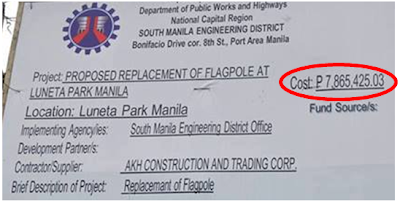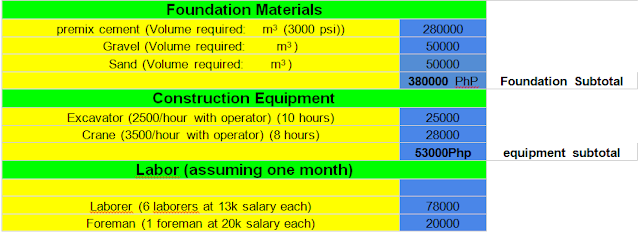Floods in the Philippines
Water is vital for life. It is the substance that makes life possible here on Earth. Here in the Philippines, we take pride in being a “water” country. With us being an archipelago, the main livelihood of our countrymen lies with water. Yet the same water that brings us the most pristine beaches and the best diving spots also brings us death and destruction. Every year when the monsoon season begins, we are bombarded with storms and floods. In this article, we would model flooding as a simple engineering equation that would explain it.
 |
| Typhoon Schematic |
- Flooding can be seen as physical manifestation of MURPHY’s Law in Effect = “anything that can go wrong will go wrong”
- This states that one thing will aggravate the next, case in point:
- an informal settler will go to the riverside in Marikina
- he will dump wastes which will slow the water flow
- slower water flow means
- Clogged drainage and
- More waste will accumulate
- Up to a point that water can’t flow and even the river itself contributes to the flooding
- Then a politician refuses to do anything about the situation
- and a typhoon comes along ( IN SHORT PATONG PATONG NA SILA)
How much does typhoon and flooding cost the Philippines?
- The cost of typhoons per year in the Philippines
- According to DPWH Sec. Rogelio Singson, the economy loses $160 Million or 7 Billion PhP due to the 20 or so typhoons that visit the country every year.
- Mary Ann Lucille Sering, head of the Philippine government's climate change commission said that Typhoon-related costs in 2009, the year the commission was created, amounted to 2.9% of GDP and have been rising each year since then
- The current plans and budget of DPWH:
- The DPWH identified 11 long-term projects in its P351.7 billion flood-risk management master plan for Metro Manila and nearby areas that was completed last year.
- Pasig-Marikina River improvement and dam construction project of P198.4 billion,
- The Manila Core Area drainage improvement program with P27.2 billion budget.
- P50 billion budget East Mangahan Floodway project, which covers Cainta and Taytay River improvement; and the West Laguna Lakeshore land raising project.
- The Malabon-Tullahan River improvement, on the other hand, will get P21.6 billion budget
- P17.3 billion for South Parañaque-Las Piñas River improvement.
- The other projects are Meycauayan River improvement (P14 billion);
- Valenzuela-Obando-Meycauayan Improvement (P8.6 billion);
- Land Raising for Small Cities around Laguna Lakeshore (P7.1 billion),
- West Mangahan Area Drainage Improvement (P5.5 billion),
Now that we understand the problem, we try to solve it using a basic Flooding Formula :
- Floods are caused by rainwater trying to find a lower settling spot, in most of the case, the sea.
- As a steady state steady flow phenomenon, flooding can be simply and accurately modeled by the following Equation
 |
| Flood=Water In-Water Out+Obstacles to Flow-Suction of Flood |
Flooding should also be viewed with a volume - time perspective, so all units in our equation are in m^3 / s.
This changes flooding from a static water mass to more of a flow rate that it really is.
Now, Let’s try applying this to the most infamous flood of recent history – Ondoy
First, we define our parameters:
- Control Area = Metro Manila
- Land Area of Metro Manila =638.6 km² (** Will be much greater if we consider water from the nearby provinces and Sierra Madre Mountains )
Water In
Let’s take a look at the Infamous Typhoon Ondoy,
- Ondoy’s onslaught dumped 455 mm of rain over a 24-hour period.
- But 341 mm fell in just six hours
Computing for the Volumetric Flow Rate of Rain Water
=638,600,000 m^2 (Area of NCR )*.455m ( average height of rain) * (1day / 24 hours) (from 1 day converting to seconds)/(1hour / 3600sec ) = 3362.99 m^3/s – water in
Water Out
Water Out from Metro Manila has 2 major routes
- To Manila Bay -> Pasig River approximate value is around 410 cubic meters.
- To Laguna de Bay -> We consider this, since it accommodates majority of the water flow from Metro Manila and the nearby provinces. By design, it has the Manggahan Floodway is capable of handling 2,400 cubic meters per second of water flow, but the actual is close to 2000 cubic meters.
“ Fact: During the height of the storm, the Marikina River had a flow of about 3000 m³/s (106,000 ft³/s), and the head of the UP National Hydraulic Research Center stated that the floodway could have handled this flow without overflowing if there were no settlers on its banks.”
Obstacles to Flow
There are many obstacles to flow but most noticeable and important would be clogging due to garbage.
Average Trash per Person in Manila = .7kg> .3kg average in the world
We here in Manila are highly Urbanized, overpopulated yet our garbage collection system is lagging.
Number of Informal Settlers in Manila is estimated to be at 520,000 families, estimated that each family is to have 6 members, then we have roughly 3-4Million informal settlers in Manila.
Demographics of our Trash
Estimated trash per person is .7kg, converted to volume is roughly .07m^3
Estimating that each family throws wastes into the river or dump, that would be a deterrent of around 210,000m^2 of flow area. This figure translates into worse floods. But we believe that trash has a “cumulative” / percentage effect on flooding.
An accurate figure that can model the effect of garbage would be the Manggahan Floodway. It is capable of handling 2,400 cubic meters per second of water flow, but the actual is close to 2000 cubic meters. The primary reason for this would be garbage. Trash decreases flow rate by around -18%. – we would use 18% as a correction factor that slows water down.
Suction of Flood
How much water can a tree hold?
- One large tree can lift up to 100 gallons of water out of the ground and discharge it into the air in a day. That’s only 0.00030299 m^3
Number of trees in Manila can be approximated to 1 person = 60 trees, but since we live in a city, we can safely use half of that so 1 person = 30 trees.
And NCR has 12 million people, so that’s about 108000 m^3 per day of flow rate sucked in,
Changing it to m^3 / s that’s only around 1.25m^3 / s (NEGLIGIBLE, very small value)
As we can see, it is easier to block the flow of water rather than suck it out.
*** Another thing to note that will help in the suction of floods are pumping stations, these mechanical marvels are supposed to remove flooding altogether, unfortunately, most if not all of the 52 pumping stations in manila are
- in need of dire rehab
- No fuel to operate the generators
- Stocked up themselves
We don’t consider these since they are missing in action last Ondoy.
Substituting Values To Our Governing Equation
Flood=(Water In)-(Water Out)+(Obstacles to Flow)-(Suction of Flood)
Flood=5000 from study (water dumped by Ondoy) – 2000 (water carried by Manggahan floodway) – 410 (water carried away from Pasig River) + .18(3362.3) (effect of trash on the flow rate of the 2 rivers) -1.25 (trees sucking in water)
Flood = 3193.964m^3 /s
~quod erat demonstrandum (the conclusion of the demonstration)
Some frequently overheard dialogues
- From a tricycle driver in Recto: “Umuulan na, takpan niyo nang plastic ang imburnal para bumaha at dumami pasahero.”
- From a city engineer and or well-meaning politician in Espana : “ Taasan mo nalang ang kalsada, para lumipat sa iba ang baha. Sila na bahala diyan, kaya na nila yan”
- From a street kid in Quiapo: “Sana tumaas pa ang baha, para makapag Olympic diving kami sa Quaipo underpass”
- From students in U belt : “ Yehey!! No classes!! DOTA NA!! teka teka, e brownout e..”
- From a TV personality to his Dancer girlfriend : “ Ang lamig, ang dilim, tawagan ko nga ang maganda kong girlfriend para gumawa kami ng “music video” hihi.
- From an evacuee in Marikina : “At least sa evacuation center may relief goods at sopas, plus may libreng damit at pagkain pa, plus ma T-TV pa ako hehe”
- From a wealthy person in White Plains : “ Really now? It’s raining hard and flooding deep? I’m warm and safe here in my house. YAYA bring in more firewood! ”
- From a Chinese relief goods businessman in 168 : “Akin payong ikaw bili; di ikaw basa yan, ako bigay pa sa iyo libre kapote wag na ikaw tawad ok?.”
- From a high profile government convict:“ It’s raining and flooding!! Another excuse to delay my hearing hehe.”
References:
http://newsinfo.inquirer.net/244837/tuesday-rains-surpass-ondoys-2009-rainfall-pagasa#ixzz2fLQqWqv4
http://flood.dpri.kyoto-u.ac.jp/ihp_rsc/riverCatalogue/Vol_05/9_Philippines-4.pdf
http://cids.up.edu.ph/chronicle/articles/chronv4n1and2/infocus16nantes_pg1.html
http://web.mit.edu/16.unified/www/FALL/thermodynamics/thermo_6.htm
http://en.wikipedia.org/wiki/Manggahan_Floodway
http://www.tempo.com.ph/2013/07/old-problem/
http://manilastandardtoday.com/2013/06/30/typhoons-cost-160m-a-year/
http://www.theguardian.com/world/2013/feb/17/filipino-super-typhoon-climate-change
http://www.dti.gov.ph/dti/index.php?p=321
http://www.nscb.gov.ph/secstat/d_income.asp
http://www.pinoymoneytalk.com/philippines-city-per-capita-income/
http://www.journals.upd.edu.ph/index.php/socialsciencediliman/article/.../7
http://www.greenprophet.com/2013/01/5-reasons-to-be-grateful-for-trees-on-tu-bshevat/
http://journeytotheplasticocean.wordpress.com/2012/09/03/the-great-hk-garbage-patch/
http://en.wikipedia.org/wiki/2012_Philippines_flooding


























